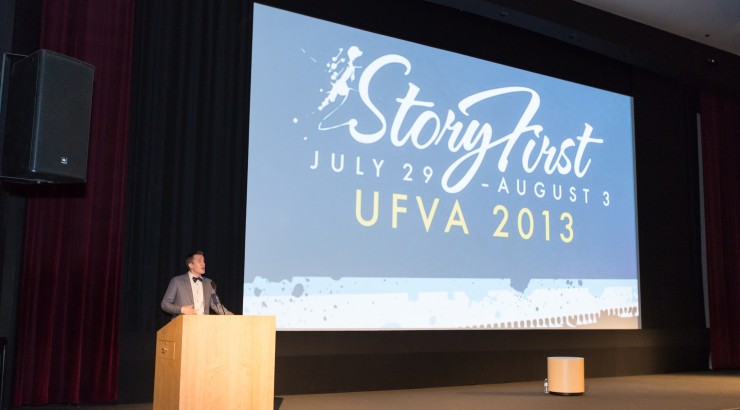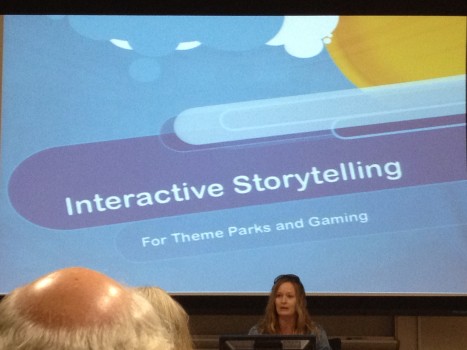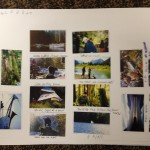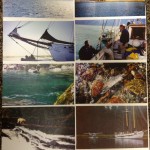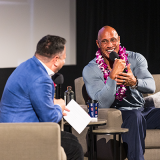Trends at UFVA: Transmedia – Telling a Story Across Media
August 7, 2013
Transmedia, or the breaking apart of a single story into multiple different mediums, was one of the most fascinating emerging trends discussed at the UFVA conference this week.
With numerous one-off courses and lectures, one could definitely attend the UFVA conference and learn about a different in every single session you attended. But, the conference programmers took great pains this year to create a few different threads of connected topics across the various days and panels in the con. For instance, no less than 10 sessions featured faculty members discussing the problems and opportunities they encountered in the past year of teaching emerging digital trends to students; an entire series of short film screenings were devoted to allowing faculty and admins to screen works in progress for the attendees, from whom they would request feedback and advice from their colleagues; another example is the presentations made by and about Chapman University faculty members, which I’ll discuss in more detail tomorrow.
Of the various trends in panels programmed across the UFVA conference, the one I think would be most exciting to film studies, film production, advertising, and prospective students alike is the panels’ focus on
transmedia
.
Transmedia essentially refers to telling a story across multiple different mediums. So for example, if you think back to the Avenger’s release last summer, you may recall a major promotion that the advertisers ran in conjunction with the Target superstores. Shoppers encountered a few oversized cardboard figures of the main action heroes, with signage describing part of their role in the film and part of their backstory, which wasn’t included in the actual film. These cut-outs encouraged shoppers to download an iPhone/Android smartphone app, in which the user played through the story of one of the main heroes, and which allowed them to take real-life snapshots with the figures inscribed over the real world (a process called augmented reality) to make it look like they were posing with, for example, The Hulk. This is one simple example of transmedia, or the breaking apart of the single-screen story, into multiple devices, involving multiple media, in multiple places.
Numerous panels at UFVA focused on describing the advent of transmedia in our culture and how it’s evolving. One such panel discussed Disney, as the very first transmedia experience -something I’d never thought about, but as a local southern Californian myself, have had multiple chances to observe. Walt Disney’s idea for the theme parks was to bring the story to life, off the big screen, into the lives of the viewers, in an experience far less passive than what we get in the movie theater. Disney has continued it’s adventures in “placing the audience within the story” through today, with advances in technology allowing the imagineers to tell ever more complex and encompassing stories. Visitors to Epcot center today, will find an interactive experience where children are given mock cell phones, which direct them to various places throughout the center, allowing them to learn more about other cultures as they progress through the game. It’s essentially a treasure hunt dressed up in Disney properties, but at the same time transforms the experience of exploring Epcot, bringing children and their parents into the story as they go. Some other examples she discussed were “Turtle Talk with Crush” (at our own Disneyland park!), “Lucky the Dinosaur”, and “Agent P’s World Showcase Adventure.”
Another presenter focused on the lessons of the video game industry, which by its very nature, places the player within a world they can explore, which is in itself a kind of transmedia narrative. Where videogames differ from traditional media, they often allow the player to arrive at one of many different outcomes, which complicates the storyteller’s job at providing a truly meaningful experience from start to finish, regardless of the choices the player makes.
Such problems are often encountered by the new wave of interactive filmmakers, at the heart of the transmedia culture, as described in “Problems in Transmedia Narrative” and its corollary panels. In Thursday’s Workshop, “Transmedia Storyboarding for Production” Professor Rebekah Jorgensen (Webster University) brought participants into an active exercise meant to test their ability to tell a story in a transmedia narrative. She broke the audience into small working groups, and gave them each the same set of small images. Each group was tasked with forming a narrative from these otherwise descriptionless pictures, a simple story that could be made into a video of 2-5 minutes in length. In successive stages of the exercise, each team was asked to add on more and more elements of the story as she added additional photos, except each additional element was meant to represent another aspect of the story
not
seen on the screen in the short film. These narrative elements were assembled into storyboards, and the participants asked to create a ‘pitch’ for how they would sell these multifaceted stories to an executive by describing them in terms of branding, merchandize, ancillary products and so on. Here are some examples of the groups’ storyboards:
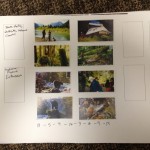
Given our students’ interest in expanding the ways stories can be told, both onscreen and off, through the various but related majors taught here at the College, I wouldn’t be surprised to see similar ideas and projects popping up in classes. Even better, such projects could be of interest to film production and advertising students alike, or even Film Studies and Screenwriting alike, forming some interesting bridges through the school. This is one of the many cool aspects of attending a small, but focused College with ties to so many different fields: you never know what could come out of the collaborations you’ll be part of while you’re here!
